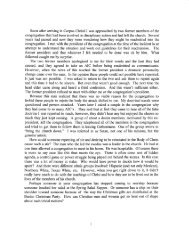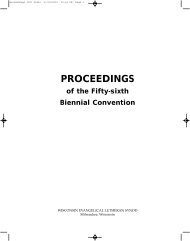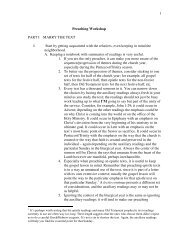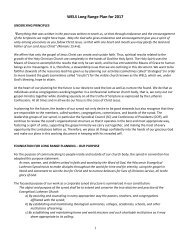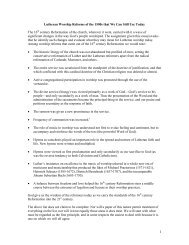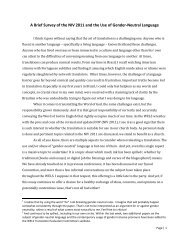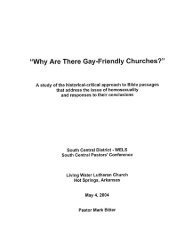A History of the WELS - The South Central District
A History of the WELS - The South Central District
A History of the WELS - The South Central District
You also want an ePaper? Increase the reach of your titles
YUMPU automatically turns print PDFs into web optimized ePapers that Google loves.
every ten congregations) to <strong>the</strong> district organization working under <strong>the</strong> supervision <strong>of</strong> <strong>the</strong> conference visiting<br />
elder. <strong>The</strong> responsibility <strong>of</strong> <strong>the</strong> circuit visitor was restricted to “<strong>the</strong> implementation <strong>of</strong> <strong>the</strong> Synod’s financial<br />
program as it relates to <strong>the</strong> individual congregation.” Exercising “evangelical procedure based on Scriptural<br />
injunction and admonition,” <strong>the</strong> circuit visitors were instructed to “<strong>of</strong>fer counsel and assistance to congregations<br />
in achieving proportionate giving for <strong>the</strong> Synod’s program.”<br />
<strong>The</strong> implementation <strong>of</strong> this method lagged, and in 1971 <strong>the</strong> Conference <strong>of</strong> Presidents proposed a new<br />
approach. <strong>The</strong> Conference <strong>of</strong> Presidents recommended that <strong>the</strong> number <strong>of</strong> congregations for which <strong>the</strong> visitor<br />
elder was responsible be reduced to approximately 10-15 (previously it had been as many as 40 in some<br />
districts), and <strong>the</strong> concept <strong>of</strong> circuit visitors be abandoned. At <strong>the</strong> Synod Convention <strong>of</strong> 1975 <strong>the</strong> bylaws <strong>of</strong> <strong>the</strong><br />
<strong>District</strong> Constitution and <strong>the</strong> Constitution <strong>of</strong> Synod were revised to allow for such a program and <strong>the</strong> term<br />
“Visiting Elder” was changed to “Circuit Pastor.” 43 At least once a biennium circuit meetings (or conferences)<br />
were to be held consisting <strong>of</strong> pastors, male teachers and lay delegates <strong>of</strong> congregations to hear reports on and<br />
discuss <strong>the</strong> work <strong>of</strong> <strong>the</strong> Synod. Circuit Pastors were to visit each pastor in <strong>the</strong>ir circuits once every four years to<br />
streng<strong>the</strong>n <strong>the</strong> unity <strong>of</strong> <strong>the</strong> Spirit, to discuss <strong>the</strong> manner in which <strong>the</strong> goals and programs <strong>of</strong> <strong>the</strong> Synod were<br />
being carried out, and to <strong>of</strong>fer assistance in solving local problems. A Handbook for Circuit Pastors was also<br />
published.<br />
During <strong>the</strong>se years Synod was never able to keep pace with <strong>the</strong> needs for building and maintenance at<br />
its educational institutions. No sooner had <strong>the</strong> Second Phase <strong>of</strong> <strong>the</strong> Wisconsin Synod Building Fund or<br />
Centennial Collection been completed in 1953, than <strong>the</strong> “Gift for Jesus” Collection was proposed. 44 <strong>The</strong> “Gift for<br />
Jesus” Collection Committee was appointed September 29, 1953 and met during <strong>the</strong> special sessions <strong>of</strong> <strong>the</strong><br />
Synod in Milwaukee on October 8, 1953. December 13, 1953, was set for <strong>the</strong> date <strong>of</strong> <strong>the</strong> “Christmas Gift for<br />
Jesus” Collection; December 20 was designated as Thanksgiving Sunday.<br />
<strong>The</strong> “Gift for Jesus” Collection was intended to raise enough money to build a dormitory, dining hall, and<br />
classroom-chapel building at Northwestern College, a dining hall, kitchen, and central heating plant at Michigan<br />
Lu<strong>the</strong>ran Seminary, and a music hall at Doctor Martin Lu<strong>the</strong>r College. Synod had voted $950,000 for<br />
Northwestern College, $135,000 for Michigan Lu<strong>the</strong>ran Seminary, and $40,000 for Doctor Martin Lu<strong>the</strong>r<br />
College. Promotional material was prepared and sent out to all congregations. <strong>The</strong> Thanksgiving issue <strong>of</strong> <strong>the</strong><br />
Northwestern Lu<strong>the</strong>ran, November 29, 1953 was dedicated to <strong>the</strong> “Gift for Jesus” Collection. A slide-lecture was<br />
also prepared by <strong>the</strong> Board for Information and Stewardship.<br />
Within one and one-half years $973,928.83 (April, 1955) was collected. <strong>The</strong> total amount collected<br />
reached $1,282,657.01. <strong>The</strong> dining hall, kitchen, and central heating at Michigan Lu<strong>the</strong>ran Seminary were<br />
dedicated on September 12, 1954 and cost $134,999.87. <strong>The</strong> dining hall, dormitory (East Hall or Augsburg Hall)<br />
and <strong>the</strong> Chapel-Arts building at Northwestern College were all dedicated on August 21, 1956 and cost a total <strong>of</strong><br />
$1,210,462.46. Doctor Martin Lu<strong>the</strong>r College did not receive <strong>the</strong> requested Music Hall.<br />
<strong>The</strong> Board <strong>of</strong> Trustees reported <strong>the</strong> dreadful state <strong>of</strong> <strong>the</strong> Building Fund to <strong>the</strong> Synod Convention <strong>of</strong><br />
1965. At <strong>the</strong> Convention <strong>of</strong> 1963 <strong>the</strong> delegates to Synod voted a budget 26.5 percent beyond <strong>the</strong> funds<br />
subscribed, but actually empowered no Board to ask <strong>the</strong> various departments to adjust <strong>the</strong>ir plans through<br />
mutual consultation and joint planning. <strong>The</strong> budget planning that had been done proved inadequate, and <strong>the</strong><br />
Synod’s contingency fund was wiped out shortly after <strong>the</strong> Convention <strong>of</strong> 1963. <strong>The</strong> result was that, with <strong>the</strong><br />
payment <strong>of</strong> all budgetary bills, <strong>the</strong> Building Fund (<strong>the</strong> only source from which <strong>the</strong> Board <strong>of</strong> Trustees could draw<br />
at <strong>the</strong> end <strong>of</strong> <strong>the</strong> fiscal year) had been more than depleted. Thus, <strong>the</strong> Synod, as <strong>of</strong> June 30, 1965, had a building<br />
fund indebtedness <strong>of</strong> over $840,000.<br />
<strong>The</strong> Board <strong>of</strong> Trustees <strong>the</strong>refore proposed a plan <strong>of</strong> raising $2,000,000 by a ‘special’ collecting and<br />
borrowing an additional $2,000,000 to carry out <strong>the</strong> financing <strong>of</strong> <strong>the</strong> proposed Educational Institutions Building<br />
Program. <strong>The</strong> projects proposed by <strong>the</strong> Planning Committee for <strong>the</strong> Educational Institutions <strong>of</strong> Synod and<br />
adopted by <strong>the</strong> Synod were a multi-purpose gymnasium-auditorium-student-union-refectory building in New<br />
Ulm; a gymnasium and dormitory in Watertown, a multi-purpose library building in Mequon; and an academic<br />
plant with classroom facilities for 250 students in Milwaukee. But Synod, instead, resolved to authorize a<br />
20<br />
42 cf. Proceedings, 1965, p. 379.<br />
43 cf. Proceedings, 1975, pp. 105-106.<br />
44 cf. pp. 69-70 above.



